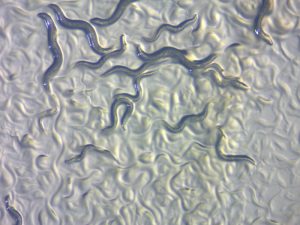Enter your address to receive notifications about new posts to your email.
Articles tagged Model Organisms
(74 results)
-
The mouse lemur: a new genetic model organism
Palm fronds crunch under a researcher’s foot as she hikes through a rainforest in Madagascar looking for a spot to release a tiny, omnivorous ball of fur with bulging eyes—a mouse lemur. This creature, the smallest type of primate, is an important research subject: it has just yielded a blood sample, skin cells, and an…
-
Housekeeping genes escape miRNA repression through alternative polyadenylation
Changing where the polyA tail is added to an mRNA transcript can fine-tune the tissue-specific expression of many genes, reports a Caenorhabditis elegans study published in the June issue of GENETICS. Blazie et al. show alternative polyadenylation (APA) allows transcripts to evade microRNA (miRNA) silencing in some tissues, allowing for tissue-specific expression of those genes.…
-
Behind the cover: Male infertility in the mouse Collaborative Cross
Fascinating discoveries sometimes emerge from the most daunting of experimental roadblocks. Designed to generate over 1,000 recombinant inbred mice lines for genetic mapping, the Collaborative Cross (CC) project unearthed astounding variation in male fertility when nearly 95% of the highly inbred CC lines went extinct. As part of the Multiparental Populations series in the June…
-
On the cover: Daphnia in the spotlight
Illuminating the cover of the May issue of G3 is a lake-dwelling filter feeder no more than a couple millimeters long. This microcrustacean—Daphnia pulex, also known as the water flea—is an important model organism, especially in ecological genetics. But despite Daphnia’s status as a model organism, no one had examined its population genomics until now.…
-
Tools for transgenic studies in close relatives of D. melanogaster
Thanks to more than a hundred years of working with Drosophila melanogaster, geneticists have many powerful tools for precisely manipulating its genes. It has also become a model system for studying speciation and molecular evolution together with the other members of the melanogaster species group: D. simulans, D. mauritiana, D. yakuba, and D. santomea. However,…
-
Twenty years of the Worm Art Show
In 1997, Ahna Skop approached her graduate advisor, John G. White, about adding a worm-themed art show to the International C. elegans Conference he was organizing that year. “He said I could do whatever I wanted, but not to involve him,” she recalls. That year marked the very first Worm Art Show, which has since…
-
At the March for Science blog: Why scientists care so much about gnats, weeds, and brewer’s yeast
Why are scientists so interested in the health of seemingly insignificant creepy crawlies, vermin, microscopic blobs, and spindly weeds? This question is considered in a guest post up today on the March for Science blog by GSA Communications Director Cristy Gelling and University of California, Berkeley grad student Nicole Haloupek. Artist and Sanger Institute postdoc Alex…
-
50 years of molecular evolution in Drosophila
In the genomic era, population geneticists are flooded with molecular data on the evolution of natural populations. This deluge started in 1966 as a trickle of data from protein electrophoresis studies, including the landmark GENETICS papers published by Richard Lewontin and John Hubby. As Lewontin is honored this week at the Annual Drosophila Research Conference…
-
The tiny worm with a big impact
These worms are as long as a pencil’s tip and only just visible without a microscope. They are among the smallest multicellular animals, but they still have complex organ systems. They are Caenorhabditis elegans, one of the most important organisms in modern biology and a key to understanding the most basic molecular processes of life.…
-
Fly model of traumatic brain injury untangles factors tied to mortality
Each year, emergency departments in the US treat almost 700,000 people for traumatic brain injury (TBI). The outcome depends largely on the severity and location of the injury, but these aren’t the only factors. Age also plays a role, with children often recovering more fully than do adults. The patient’s diet following the injury may…
-
High Temperatures Suppress Seizures in a Fruit Fly Epilepsy Model
The human brain is an amazing machine powered by electricity. Carefully controlled patterns of changing electrical charges in neurons allow us to to think, move, and speak. When this system is disrupted, very bad things happen. A seizure occurs when a sudden surge of electrical activity in the brain interrupts normal functioning. Seizures are accompanied…










![Traumatic brain injury is a risk for those who participate in contact sports, such as boxing and Muay Thai. By Eric Langley [CC BY 2.0], via Wikimedia Commons.](https://s36063.pcdn.co/wp-content/uploads/2016/12/npjxWixCqK0OdXXC-pic-300x199.jpg)
